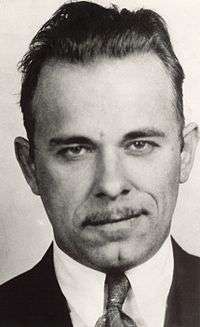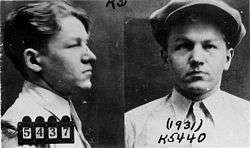Public enemy
Public enemy is a term which was first widely used in the United States in the 1930s to describe individuals whose activities were seen as criminal and extremely damaging to society, though the phrase had been used for centuries to describe pirates and similar outlaws.
Origin and usage
The phrase originated in Roman times as the Latin hostis publicus ("enemy of the people"), typically translated into English as the "public enemy".
The modern use of the term was first popularized in April 1930 by Frank J. Loesch, then chairman of the Chicago Crime Commission, in an attempt to publicly denounce Al Capone and other organized crime gangsters.[1]
In 1933, Loesch recounted the origin and purpose of the list:
I had the operating director of the Chicago Crime Commission bring before me a list of the outstanding hoodlums, known murderers, murderers which you and I know but can't prove, and there were about one hundred of them, and out of this list I selected twenty-eight men. I put Al Capone at the head and his brother next, and ran down the twenty-eight, every man being really an outlaw. I called them Public Enemies, and so designated them in my letter, sent to the Chief of Police, the Sheriff [and] every law enforcing officer. The purpose is to keep the publicity light shining on Chicago's most prominent, well known and notorious gangsters to the end that they may be under constant observation by the law enforcing authorities and law-abiding citizens.[2]
All of those listed were reputed to be gangsters or racketeers and most were rum-running bootleggers. Although all were known to be consistent law breakers (most prominently in regard to the widely broken Eighteenth Amendment to the United States Constitution banning alcohol) none of those named were fugitives or were actively wanted by the law. The list's purpose was clearly to shame those named and to encourage authorities to prosecute them.
The phrase was later appropriated by J. Edgar Hoover and the FBI, who used it to describe various notorious fugitives they were pursuing throughout the 1930s. Unlike Loesch's use of the term, the FBI's "Public Enemies" were wanted criminals and fugitives who were already charged with crimes. Among the criminals whom the FBI called "public enemies" were John Dillinger, Baby Face Nelson, Bonnie and Clyde, Pretty Boy Floyd, Machine Gun Kelly, Ma Barker, and Alvin Karpis.
The term was used so extensively during the 1930s that some writers call that period of the FBI's early history the "Public Enemy Era". Dillinger, Floyd, Nelson, and Karpis, in that order, would be deemed "Public Enemy Number 1" from June 1934 to May 1936. Use of the term eventually evolved into the FBI Ten Most Wanted Fugitives list.
The FBI's website describes the bureau's use of the term: "The FBI and the U.S. Department of Justice made use of the term, 'Public Enemy,' in the 1930s, an era in which the term was synonymous with 'fugitive' or 'notorious gangster.'"[3] It was used in speeches, books, press releases, and internal memoranda and remains in usage to this day.
-

John Dillinger
-

1931 Mugshot of Lester Gillis aka "George "Baby Face" Nelson"
-

"Pretty Boy" Floyd
-

Alvin "Creepy" Karpis
-

Clyde Barrow and Bonnie Parker
-

"Machine Gun" Kelly
References
- ↑ Sifakis, Carl (2005-06-30). The Mafia Encyclopedia (3rd ed.). Infobase Publishing. p. 269. ISBN 0-8160-5694-3.
- ↑ Bergreen, Laurence (1996). Capone: The Man and the Era. Simon and Schuster. pp. 365–366. ISBN 978-0684824475.
- ↑ ""Ten Most Wanted Fugitives" Program Frequently Asked Questions". The FBI / Federal Bureau of Investigation. U.S. Department of Justice. Retrieved March 4, 2016.
External links
![]() The dictionary definition of public enemy at Wiktionary
The dictionary definition of public enemy at Wiktionary